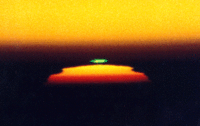
The beach along the
San Diego coast is a wonderful place to watch the sunset and with a little luck you may catch a glimpse of the Green Flash.
This rare occurrence happens just before the sun completely dips below the horizon and the atmospheric conditions are just right.
It happens fast so you have to pay attention.
It is a result of optical properties and an interesting science discussion.
Refraction is the bending of light as it travels from one medium into another medium.
As light passes through a prism, its course is altered, and in the process the various wavelengths (colors) are separated.
Sunlight is composed of every color of the spectrum, from blue to red.
Shorter wavelengths are “bent” more than longer wavelengths so as light passes through a prism it spreads out so your eye can distinguish colors.
The Earth’s atmosphere bends light in much the same way.
During a sunset light is traveling the longest distance through the atmosphere which is separating the wavelengths. The longer wavelengths (Red) gets bent the least so it appears near the bottom of the sun. The shorter wavelengths (Green and Blue) are bent the most and appear at the top of the sun.
The shortest wavelengths (Blue) are actually scattered throughout the atmosphere so much that they don’t reach your eyes so all you see is a green rim near the top of the sun. The green is visible for a few seconds and can be blocked by clouds, dust or moisture. The conditions must be just right for the Green Flash to occur. You can think of it as the last light seen is green.
The easiest way to see the Green Flash is to visit its name sake restaurant in Pacific Beach, California.
 The beach along the
The beach along the  The beach along the
The beach along the
<< Home